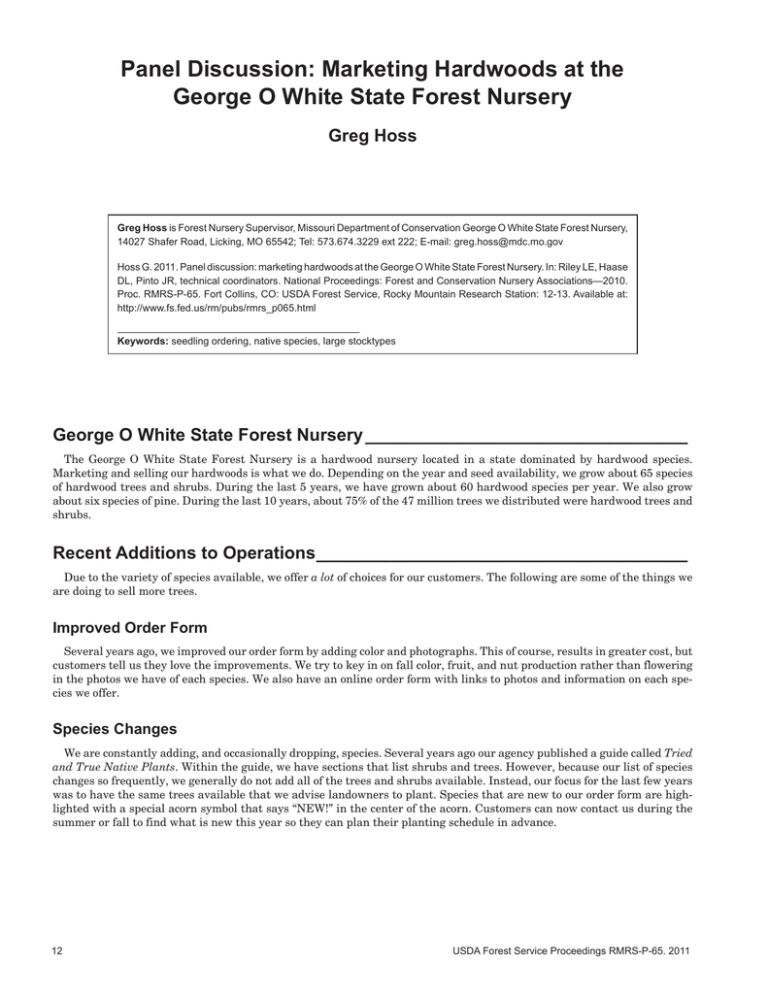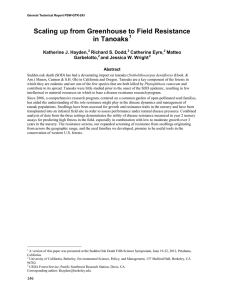Panel Discussion: Marketing Hardwoods at the Greg Hoss
advertisement

Panel Discussion: Marketing Hardwoods at the George O White State Forest Nursery Greg Hoss Greg Hoss is Forest Nursery Supervisor, Missouri Department of Conservation George O White State Forest Nursery, 14027 Shafer Road, Licking, MO 65542; Tel: 573.674.3229 ext 222; E-mail: greg.hoss@mdc.mo.gov Hoss G. 2011. Panel discussion: marketing hardwoods at the George O White State Forest Nursery. In: Riley LE, Haase DL, Pinto JR, technical coordinators. National Proceedings: Forest and Conservation Nursery Associations—2010. Proc. RMRS-P-65. Fort Collins, CO: USDA Forest Service, Rocky Mountain Research Station: 12-13. Available at: http://www.fs.fed.us/rm/pubs/rmrs_p065.html Keywords: seedling ordering, native species, large stocktypes George O White State Forest Nursery__________________________________ The George O White State Forest Nursery is a hardwood nursery located in a state dominated by hardwood species. Marketing and selling our hardwoods is what we do. Depending on the year and seed availability, we grow about 65 species of hardwood trees and shrubs. During the last 5 years, we have grown about 60 hardwood species per year. We also grow about six species of pine. During the last 10 years, about 75% of the 47 million trees we distributed were hardwood trees and shrubs. Recent Additions to Operations_______________________________________ Due to the variety of species available, we offer a lot of choices for our customers. The following are some of the things we are doing to sell more trees. Improved Order Form Several years ago, we improved our order form by adding color and photographs. This of course, results in greater cost, but customers tell us they love the improvements. We try to key in on fall color, fruit, and nut production rather than flowering in the photos we have of each species. We also have an online order form with links to photos and information on each species we offer. Species Changes We are constantly adding, and occasionally dropping, species. Several years ago our agency published a guide called Tried and True Native Plants. Within the guide, we have sections that list shrubs and trees. However, because our list of species changes so frequently, we generally do not add all of the trees and shrubs available. Instead, our focus for the last few years was to have the same trees available that we advise landowners to plant. Species that are new to our order form are highlighted with a special acorn symbol that says “NEW!” in the center of the acorn. Customers can now contact us during the summer or fall to find what is new this year so they can plan their planting schedule in advance. 12 USDA Forest Service Proceedings RMRS-P-65. 2011 Panel Discussion: Marketing Hardwoods at theGeorge O White State Forest Nursery Hoss Extra Large Trees Special Bundles In the southern US, we believe you can grow big hardwoods in one season. For us, it is often hit or miss for size in our 1+0 hardwoods, but it depends on the specifications that define big. Our extra large seedlings are specified by a minimum height (not caliper). For the oaks (Quercus spp.), blackgum (Nyssa sylvatica), walnut (Juglans spp.), tulip poplar (Liriodendron tulipifera), and a few other species, 76 cm (30 in) is the minimum height; for bald cypress (Taxodium distichum), 91 cm (36 in) is the minimum height; and for pecan (Carya illinoensis), 61 cm (24 in) is the minimum height. A bundle of 25 extra-large seedlings is double the price of the same bundle of 25 regular-size seedlings of that same species. In general, most of our extra large seedlings are 1+0 trees. With the exception of pecan and hickory (Carya spp.), we do not carry any of our hardwoods for 2 years. Extra-large seedlings are a huge hit with our customers; we nearly always sell out. In 2008, we sold as many as 119,000. When you are selling and advertising large trees, make sure your inventory is up-to-date. If you promised a customer large trees and do not have them, it may be impossible to find them at another nursery. Our nursery offers four or five specialty bundles of seedlings in a typical year. Each bundle contains five or six species, with five to ten seedlings per species, depending on the package offered. When we have a limited number of one species available, we typically offer these exclusively within a bundle. This past year, our Conservation Bundle included five seedlings of each of the six species. Four of the six species, paw paw (Asimina triloba), arrowwood (Viburnum spp.), red-osier dogwood (Cornus stolonifera), and American beautyberry (Callicarpa americana), were only available in the bundle. If a customer wanted paw paw, they had to purchase this bundle. We allocated trees for 1000 bundles and sold them all. Our method of marketing is not advertising or writing articles, it is our ability to offer something new, different, large, and of high quality. To sell our hardwoods, we grow lots of them, lots of species, offer big and regular size seedlings, add new species, and do anything else to get landowners to buy more. The content of this paper reflects the views of the authors, who are responsible for the facts and accuracy of the information presented herein. USDA Forest Service Proceedings RMRS-P-65. 2011 13
